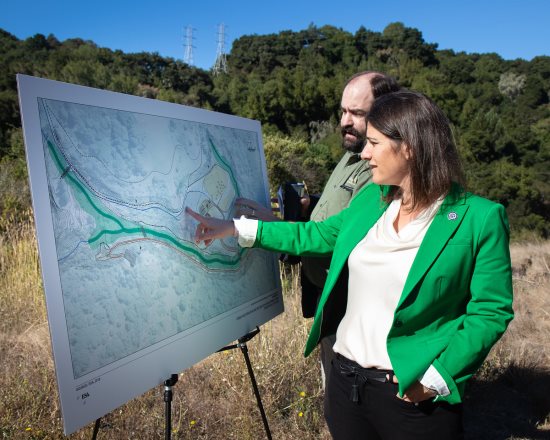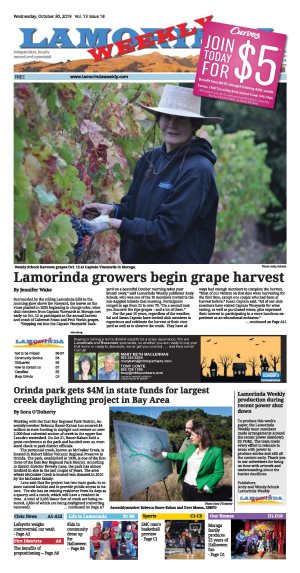|
|
Published October 30th, 2019
|
Orinda park gets $4M in state funds for largest creek daylighting project in Bay Area
|
|
| By Sora O'Doherty |
 |
| Assemblymember Rebecca Bauer-Kahan and Matt Graul, EBRPD Photo Sora O'Doherty |
Working with the East Bay Regional Park District, Assemblymember Rebecca Bauer-Kahan has secured $4 million in state funding to daylight and restore an over 2,000-foot culverted section of creek in the upper San Leandro watershed. On Oct 21, Bauer-Kahan held a press conference at the park and handed over an oversized check to park district officials.
 The perennial creek, known as McCosker Creek, is located in Robert Sibley Volcanic Regional Preserve in Orinda. The park, established in 1936, is one of the first three of the East Bay Regional Park District. According to district director Beverly Lane, the park has almost doubled in size in the last couple of years. The area where McCosker Creek is located was donated in 2010 by the McCosker family.
The perennial creek, known as McCosker Creek, is located in Robert Sibley Volcanic Regional Preserve in Orinda. The park, established in 1936, is one of the first three of the East Bay Regional Park District. According to district director Beverly Lane, the park has almost doubled in size in the last couple of years. The area where McCosker Creek is located was donated in 2010 by the McCosker family.
 Lane said that the project has two main goals: to restore natural habitat and to provide public access to nature. The site has an existing residence from its days as a quarry and a ranch, which will have a resident in time. A total of 3,035 linear feet of creek are being restored, 2,850 of which are being daylighted (culverting removed).
Lane said that the project has two main goals: to restore natural habitat and to provide public access to nature. The site has an existing residence from its days as a quarry and a ranch, which will have a resident in time. A total of 3,035 linear feet of creek are being restored, 2,850 of which are being daylighted (culverting removed).
 Overall, four acres of riparian creek habitat (creek and habitat areas around it) are being restored. This will increase the safety of the area, Lane stated, by removing large sinkholes that have developed as the culverts enclosing the creek have failed. The park will offer a campground, picnic areas, and some eight miles of hiking trails. This "big vision" Lane said, is being financed by contributions from Cal Trans Proposition 1 funds, development fees, and a river parkway federal grant of $500,000, in addition to the state grant.
Overall, four acres of riparian creek habitat (creek and habitat areas around it) are being restored. This will increase the safety of the area, Lane stated, by removing large sinkholes that have developed as the culverts enclosing the creek have failed. The park will offer a campground, picnic areas, and some eight miles of hiking trails. This "big vision" Lane said, is being financed by contributions from Cal Trans Proposition 1 funds, development fees, and a river parkway federal grant of $500,000, in addition to the state grant.
 Bauer-Kahan said she was proud to be a part of the effort. As a mom of three, she said, climate change is a big issue, and if she is going camping with her three children under age 9, she prefers to stay close to home. After presenting the oversized check for $4 million, Bauer-Kahan toured the site. "Preserving our open spaces, protecting wildlife and our environment is crucial. It is imperative the failing culvert and creek are cleaned up, stabilized, and converted to habitat as soon as possible," said Bauer-Kahan. "I am proud to partner with East Bay Regional Park District to secure funding to complete this project."
Bauer-Kahan said she was proud to be a part of the effort. As a mom of three, she said, climate change is a big issue, and if she is going camping with her three children under age 9, she prefers to stay close to home. After presenting the oversized check for $4 million, Bauer-Kahan toured the site. "Preserving our open spaces, protecting wildlife and our environment is crucial. It is imperative the failing culvert and creek are cleaned up, stabilized, and converted to habitat as soon as possible," said Bauer-Kahan. "I am proud to partner with East Bay Regional Park District to secure funding to complete this project."
 "The McCosker Creek Restoration project is the largest creek restoration project in the district's history," said EBRPD Chief of Stewardship Matt Graul. "The project restores 3,000 linear feet of natural stream channel where it's been covered up and culverted for the last 60 years." The stream restoration design will closely model the predicted pattern, profile, and dimension of a natural stream for this specific valley in order to create a low-maintenance, sustainable riparian and in-stream habitat in the long term, taking into account a changing climate, according to EBRPD.
"The McCosker Creek Restoration project is the largest creek restoration project in the district's history," said EBRPD Chief of Stewardship Matt Graul. "The project restores 3,000 linear feet of natural stream channel where it's been covered up and culverted for the last 60 years." The stream restoration design will closely model the predicted pattern, profile, and dimension of a natural stream for this specific valley in order to create a low-maintenance, sustainable riparian and in-stream habitat in the long term, taking into account a changing climate, according to EBRPD.
 The project will benefit the ecosystem for fish and wildlife, and native and rare plants. Riparian habitat will be created in an area that can support up to 10 special status wildlife species, including, for example, the California red-legged frog, golden eagle, Cooper's hawk, California foothill yellow-legged frog, Alameda whipsnake, and San Francisco Dusky-footed Wood Rat.
The project will benefit the ecosystem for fish and wildlife, and native and rare plants. Riparian habitat will be created in an area that can support up to 10 special status wildlife species, including, for example, the California red-legged frog, golden eagle, Cooper's hawk, California foothill yellow-legged frog, Alameda whipsnake, and San Francisco Dusky-footed Wood Rat.
 The project builds upon a multi-year community land use planning process and strong partnerships including Civicorps, a certified local conservation corps, as well as San Francisco Estuary Institute. The project is anticipated to be constructed over two construction seasons, in 2019 and 2020. EBRPD staff will monitor and maintain the habitat once restoration is completed.
The project builds upon a multi-year community land use planning process and strong partnerships including Civicorps, a certified local conservation corps, as well as San Francisco Estuary Institute. The project is anticipated to be constructed over two construction seasons, in 2019 and 2020. EBRPD staff will monitor and maintain the habitat once restoration is completed.
 Dave Mason of EBRPD explained that the park is home to many species of wildlife and the creek is perfect for rainbow trout, which have been spotted coming up into the property. The trout are native to the region, and the park is among the first places where rainbow trout have been studied. He added that the park district is working with professors at UC Berkeley studying terrestrial insects in the area.
Dave Mason of EBRPD explained that the park is home to many species of wildlife and the creek is perfect for rainbow trout, which have been spotted coming up into the property. The trout are native to the region, and the park is among the first places where rainbow trout have been studied. He added that the park district is working with professors at UC Berkeley studying terrestrial insects in the area. |
 |
| Photo Sora O'Doherty |
|
|
|
|
|
|
|
|
|
|
|





